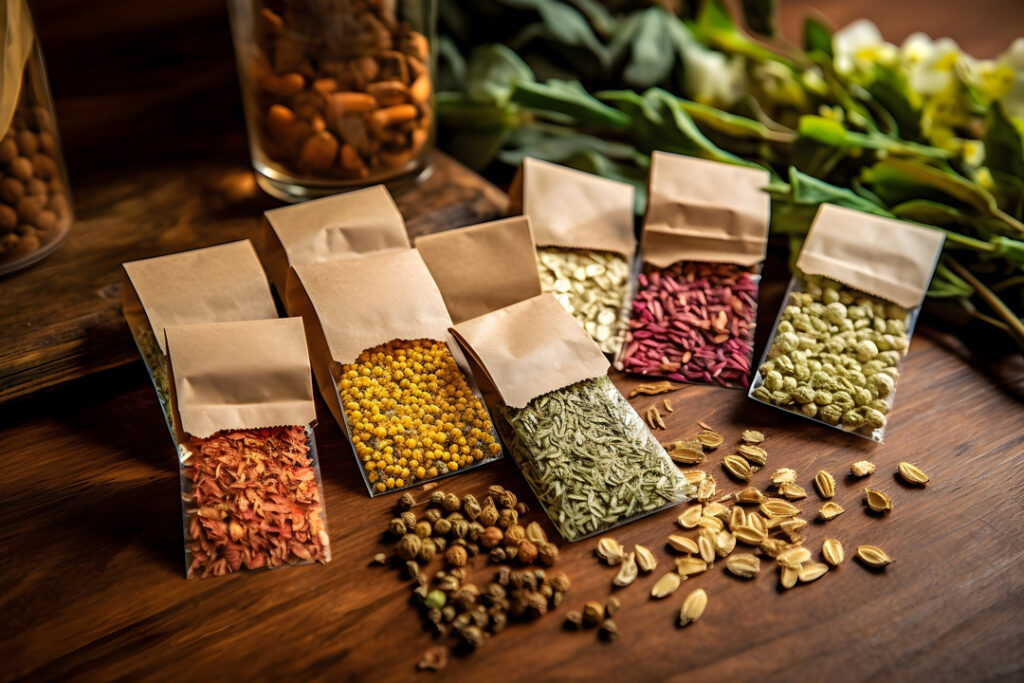Seed Saving and Seed Testing

All you plant people know how important and how beautiful seeds can be. A tiny, sometimes frustratingly small reproductive plant part contains all the genetic material and instructions needed for an entire plant to grow from the first radicle root to the full-sized flowering and fruiting crop. These seeds are small and precious, but they can actually be quite hardy. Different seeds have varying shelf lives, but most types can generally be used for several years after their “sell-by” date when stored properly. Some seeds may even keep and be viable for over 10 years.
So seeds can last for a long time, which saves us money, and allows us to store our favorite varieties and home collected seeds for more than just a single year. But what constitutes ‘proper storage’? Seeds can be stored in sealed containers, plastic bags, or wax or paper envelopes. Storage in lower humidity locations is the dominant factor in extending seed lifespans, but cool temperatures are also important. The relative humidity should be below 60% and an ideal temperature between 32F and 41F, making a refrigerator a good location. To ensure humidity remains at a reasonable level, you can use a desiccant such as a silica-gel packet or homemade alternative to absorb any excess moisture. An example of this would be using powdered milk wrapped in a piece of cheesecloth or tissue and placed into the container holding seeds. This version of homemade desiccant will need to be replaced every 6 months. Make sure all your seeds are labeled with a name, variety, and date so you can track their age throughout storage.
Although you can extend the lifespan of your seeds, they sadly will not last forever; and as seeds age their germination rates and vigor decrease. Luckily, testing the viability of your seeds is extremely easy and can help with garden planning and ensuring maximum growth capacity is reached. To perform a germination test you should follow the steps below:
- Select the seeds you would like to test.
- Moisten a paper towel and lay it out flat.
- Place at least 10 seeds on half of the paper towel and fold the other half on top. Note the quantity of seeds placed.
- Loosely roll up the paper towel with seeds and place into a plastic bag or container. Label with the name and date.
- Place in a warm area (about 70F if possible) to sped up the germination process.
- Check seeds every few days for germination. Note how many seeds germinate each day until a few days pass without any new germinations. Calculate percent germination by dividing number of seeds germinated by total number of seeds planted.
Based on the germination percentage determined, you can decide whether to use your seeds or not. If all seeds germinate, plant normally according to typical seeding instructions. If 70%-90% of your seeds germinate, then your seed is still viable but you should sow at a heavier rate. If fewer than 50%-60% of your seeds germinate then it is best to purchase new seeds.
For more specific suggestions of seeding rates based on germination, you can calculate and use what is called the pure live seed value. This represents how many of your seeds are actually capable of producing a plant and helps to accommodate for lower germination rates or higher levels of inert matter. The following formulas can be used to determine ideal planting rates if you want to be specific or are planting a large area and need to purchase appropriate quantities of seed.
Pure Live Seed (PLS) = (% germination) x (% purity)
Planting rate = recommended seeding rate / PLS
PLS will be a calculated value, % germination is found experimentally, % purity is the volume of seed that is actually pure seed (ex: inert matter, weeds, etc.), and recommended seeding rate is based on the seed packet or common practices.
You can use these fancy formulas if you are like me and enjoy math or want to become more precise with preserving your seeds and growing seedlings. Overall, just realize how important our seeds are. They are worth preserving, protecting, and cherishing. Most of the plants you see outside came from just a little seed.
Written by Nikira Lane, agAlaska Ag Tech Specialist


Comments are closed